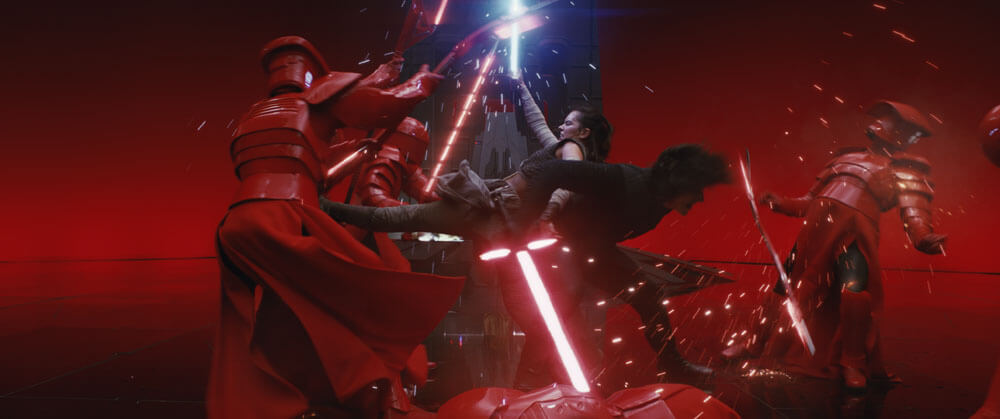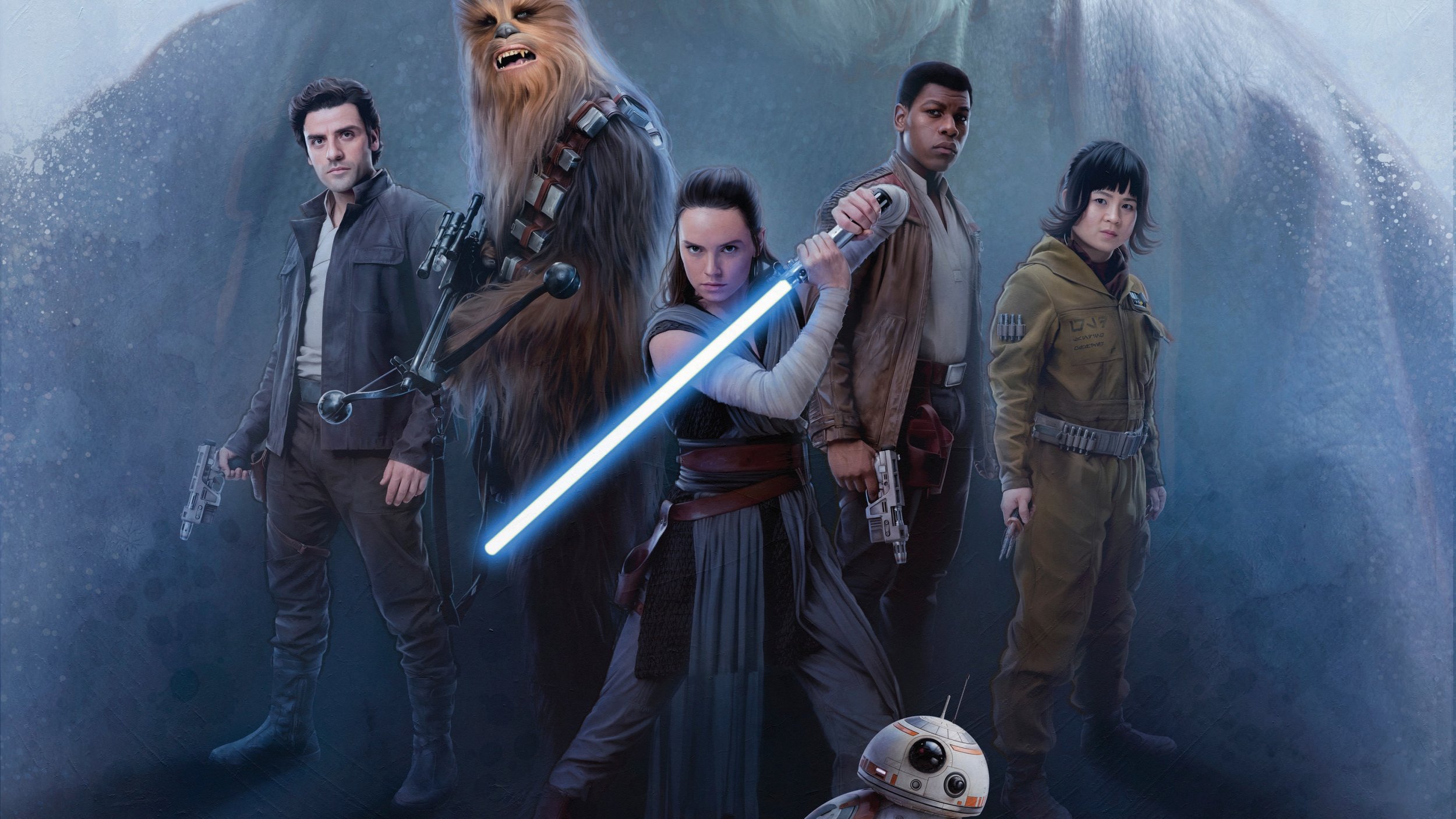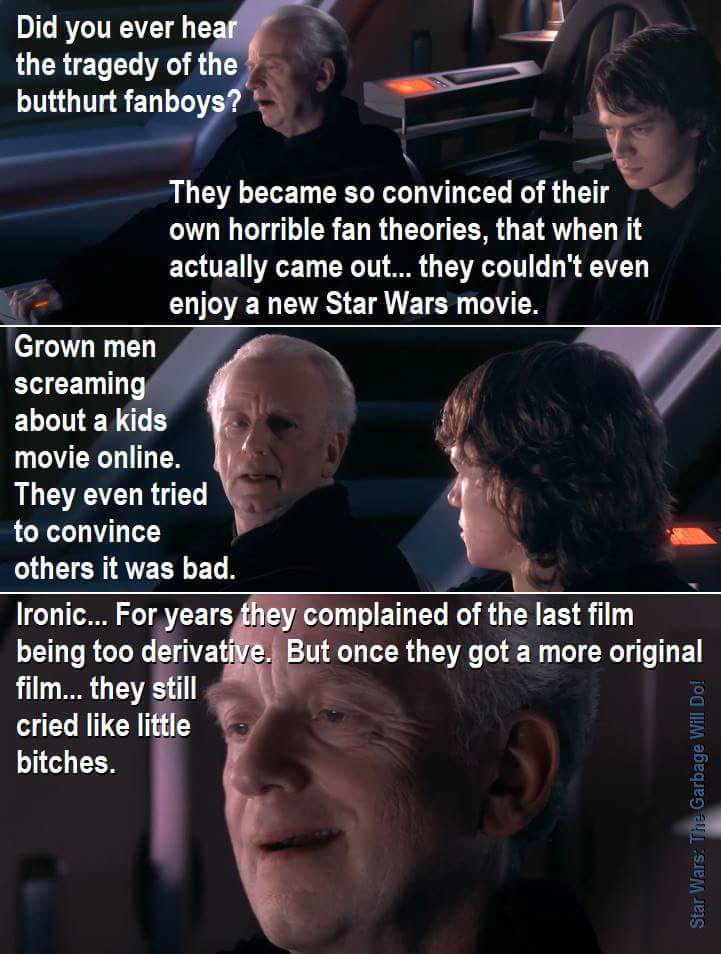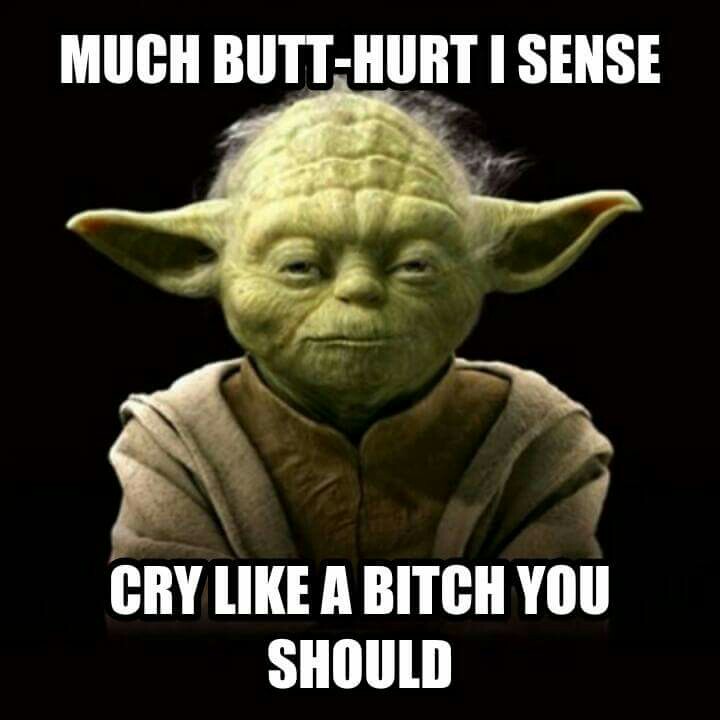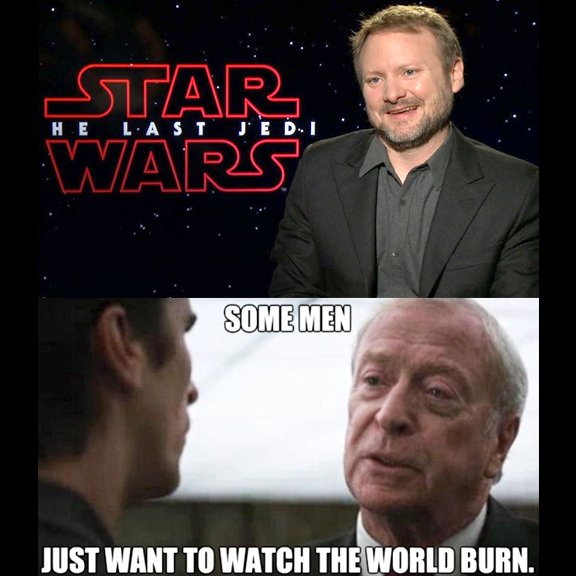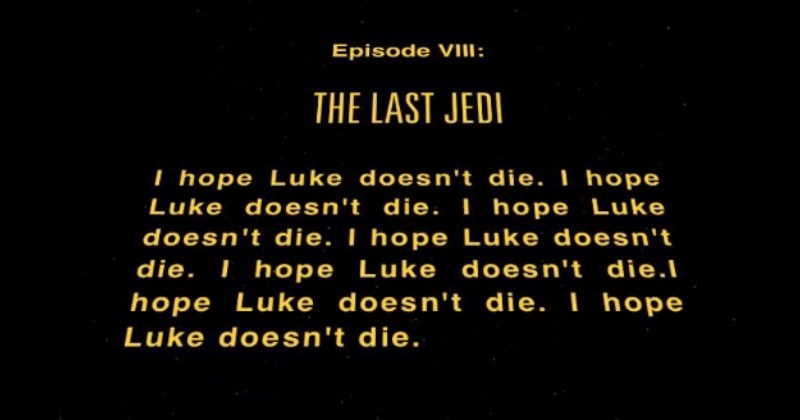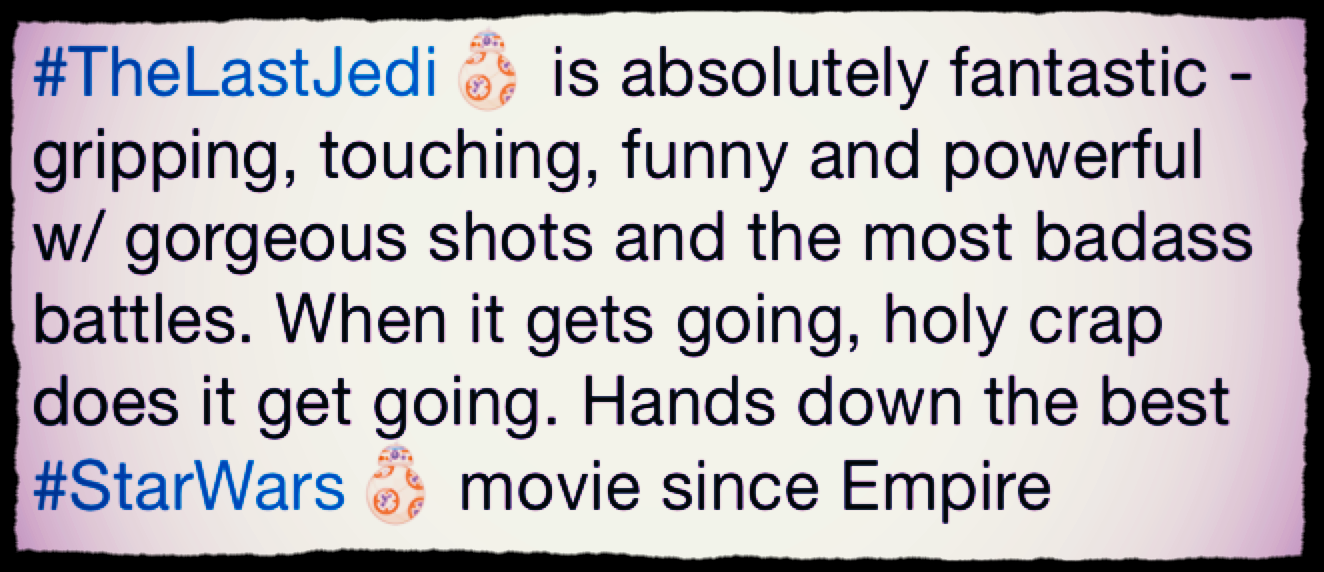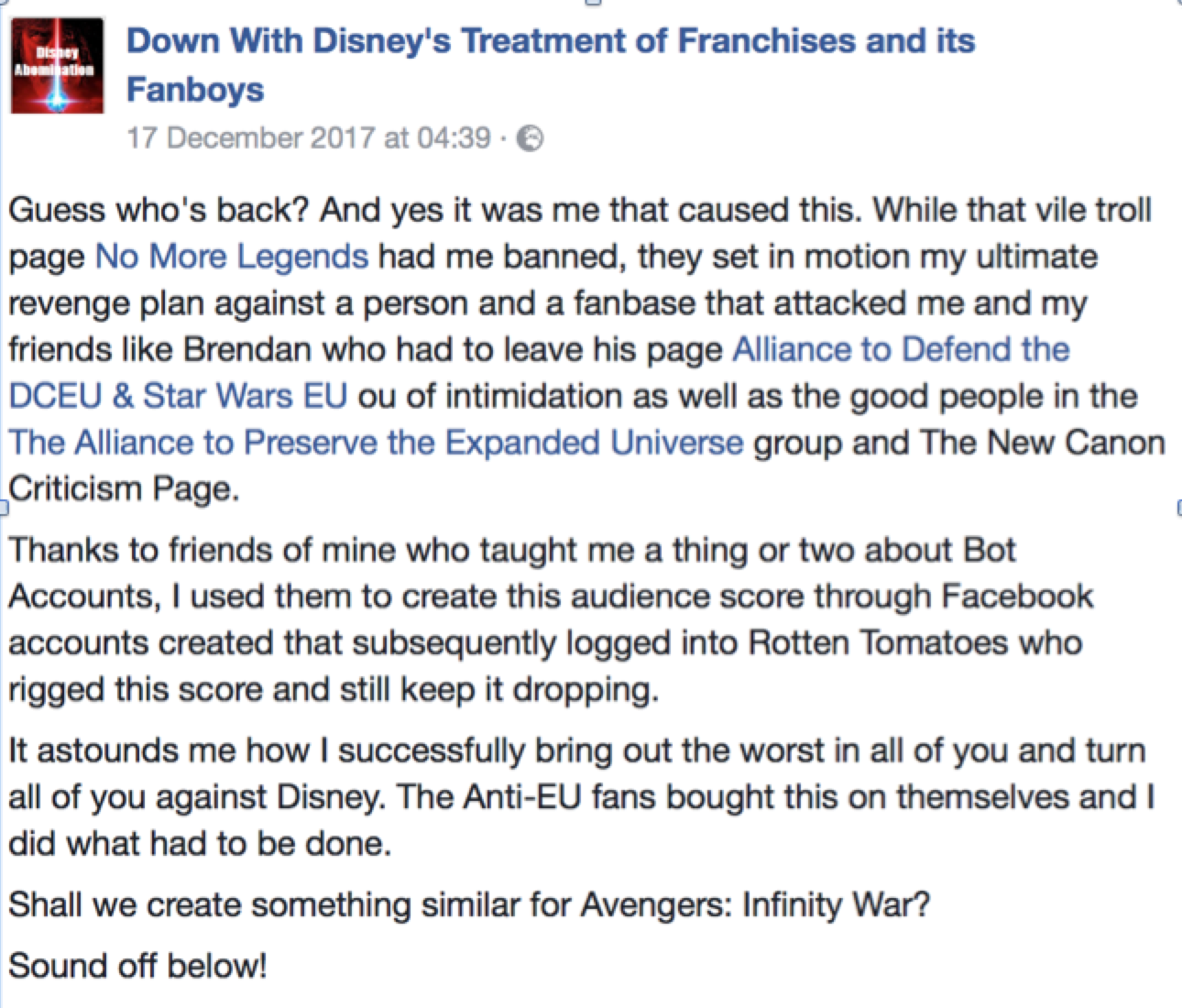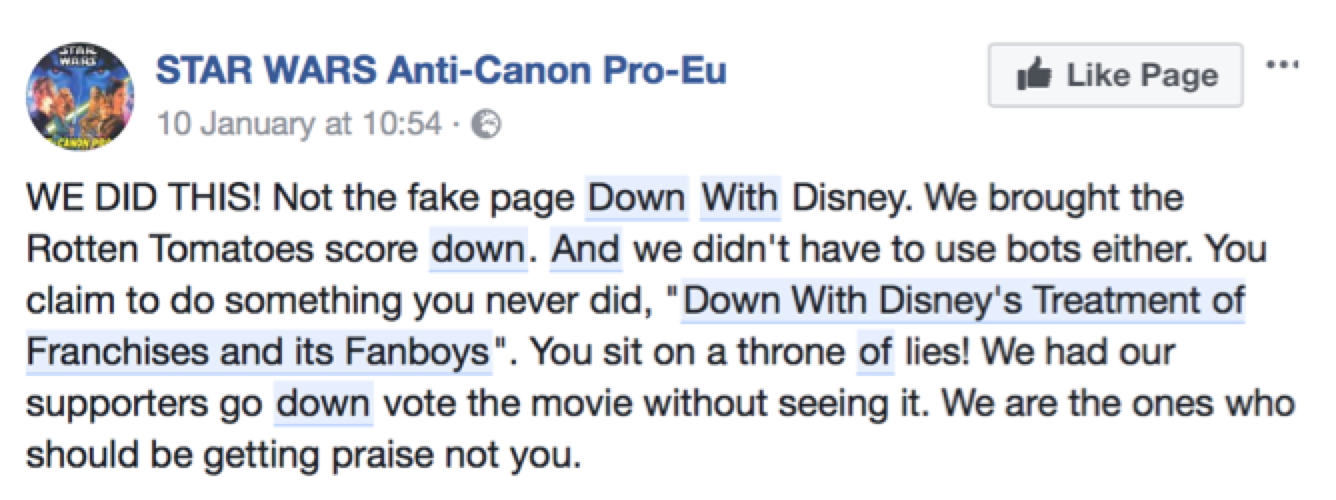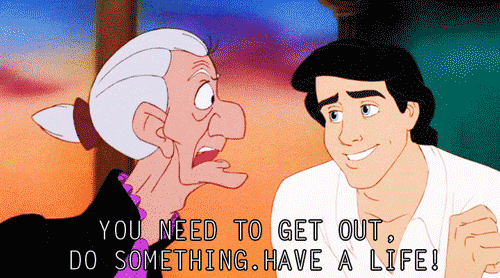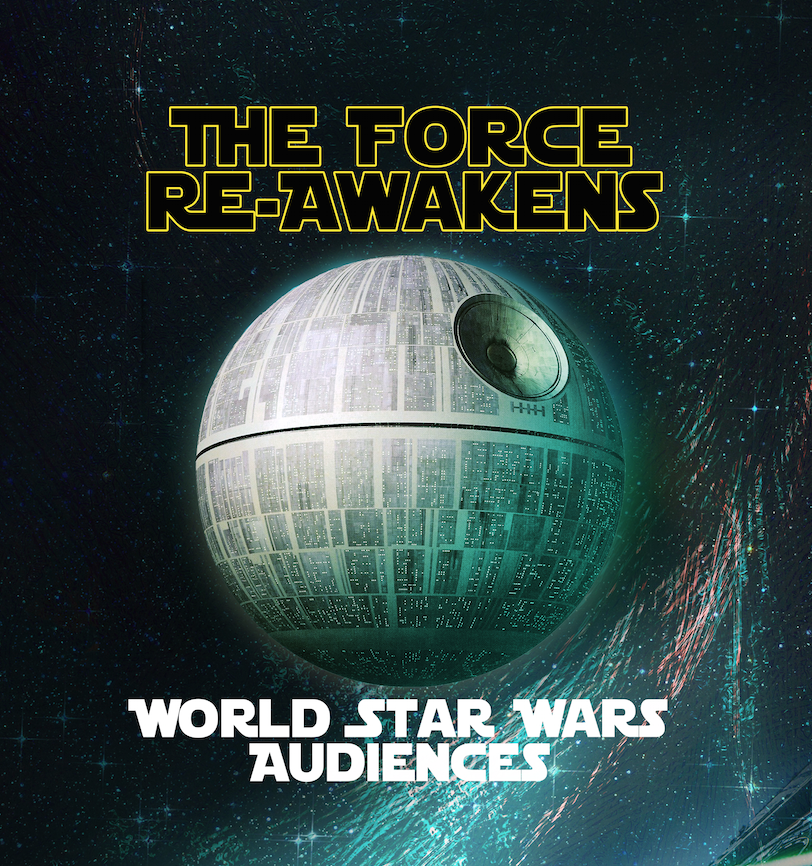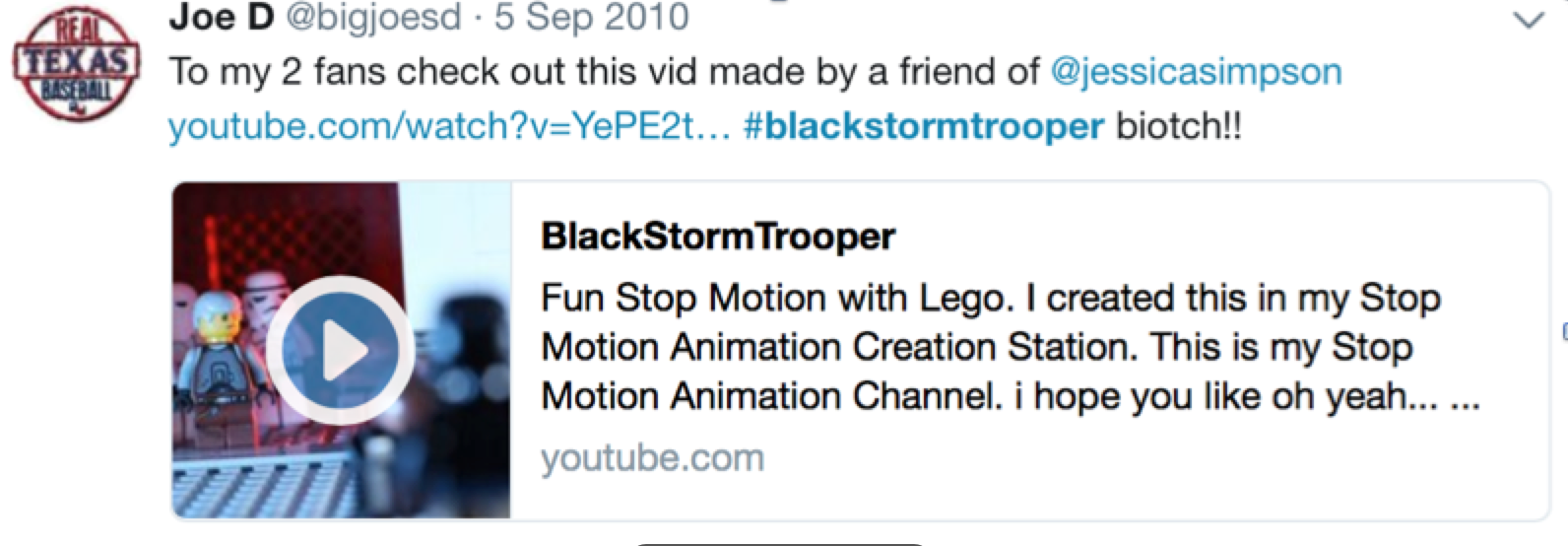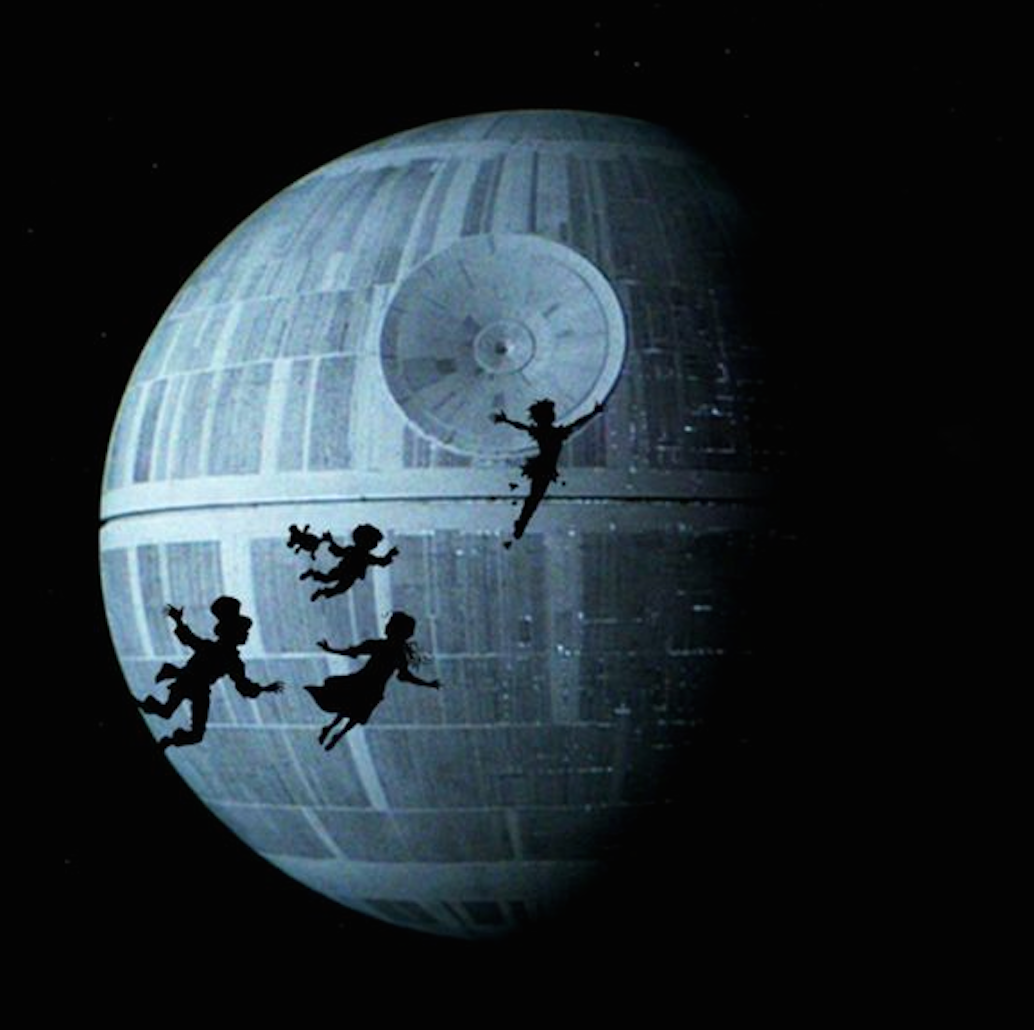The Last Jedi: An Online Roundtable Part 5
/WILLIAM PROCTOR
I’m truly sorry to hear that Becca. That’s horrible, to say the least, and it makes me so mad (although it’s not a new phenomenon, unfortunately, but that doesn’t excuse such behaviour).
I don’t intend on challenging your lived experience and I think that would be a valuable contribution to scholarship on Star Wars, perhaps even at an auto-ethnographic level. I can certainly understand that women may “fight fire with fire” in such cases. But as an empirical researcher, I’m afraid there are many examples of critics, fan-bloggers and so on — female and male — attacking fans en masse. I’m not talking about racist, misogynists either; I’m talking about attacking men because they’re men, nothing else. Also, as a researcher, it is not up to me to make moral judgements about the way in which people ‘do fandom.’ My provocation was epistemological, not moral. As Mar pointed out, and as Mel Standfill implies, there is a tendency to ignore the “dark side” of fandom, especially when women are involved as violent aggressors. So while I appreciate that women/ men are not ideological equals by any stretch, it is problematic to ignore toxic performances wherever they emanate from or to reframe them as understandable because of masculinity.
I certainly understand where you’re coming from Becca as a fan yourself, and it troubles me a great deal. It’s one of the reasons why my own fandom is kept indoors. I don’t participate in a fan “community,” for example.
However, female fans have also been toxic as Jessica Austin was analysing at the Fan Studies Network conference in 2016 (Mar and I were in the same room!) – and the majority of scholars agree that this needs to be addressed with some urgency. Austin had some powerful examples of fangirl toxicity; in one extreme case, a female fan contingent bullied a fan-artist so much that she tried to take her own life. Mar has already mentioned Swifties, but we could chuck in One Direction fans (“I will pour fucking bleach down your throat,” said one teen), or Supernatural fans, with evidence that a minority literally assaulted Jensen Ackles. That’s not something I think can be ignored by scholars, not least when there’s empirical evidence behind it, nor is it something that I think is worth “protecting” (not that you implied that Becca, I’m speaking more generally).
In addition, crossing over into other disciplines, the research on bullying is so much more frank and less fearful — one study of “mean girls in popular culture” is truly awful, not to mention the cyber-bullying research that claims that women – and girls – are particularly aggressive and hostile to other girls. So while I understand the reason why women may feel as if they need to lash out for the way they’ve been mistreated historically, perhaps in similar ways to your experience, Becca — that is, on the level of lived experience. I’m not interested in either defending or attacking fans — I’m interested in the broader picture. I recognise that I’m putting my head above the parapet, and, in many ways, that’s what I do — confront media “controversies,” and deconstruct myths via empirical methodologies. I’m sorry to say that in my research, some female fans have been quite hostile, venomous and nasty – and not always towards men, but towards women too. I strongly believe that the current state of fan studies, as well as media/ cultural studies, is not only blind to this, but actively works to construct women as victims only and reifies the very gender binaries that scholarship ostensibly aims to dismantle.
I am sure that however hurtful and alarming those comments are to you, Becca, that you did not respond in kind with slurs and insults of your own. So while it is at least understandable why some women also behaviour via the utilisation of toxic fan practices, it doesn’t mean it should be condoned as “fair game,” else we run the risk of infantilizing women all over again (which many scholars do without realising it; same with constructing the gender binaries all over again).
So my intervention is about how to deal with this on an empirical and epistemological level as scholars without making moral judgements about ‘good’ and ‘bad’ ways of being a fan. And I understand why scholars would be anxious about wading in the toxic filth and sludge of many digital spaces and I feel very ambivalent about how to frame empirical evidence that points in this direction.
I would also cite the many feminists who argue that the concept of 'Patriarchy' as an umbrella concept no longer works. I prefer the concept of Kyriarchy as I feel it allows for more complexity and nuance, not to mention permitting my own ‘white masculine privilege’ to be re-framed in order to consider my working class heritage (I was born in the British council estate ‘projects’, and existed in abject poverty for most of my life) and non-neurotypicality (I am autistic). Power is intersectional. I also think it’s interesting how concepts of ‘class’ has almost been removed from such analyses.
REBECCA HARRISON
I’m going to jump in here quickly to add that as I don’t participate in any organised fan communities I simply don’t see what is being described by Billy and Mar with regard to the toxicity of women fans, and I don’t know the scholarship on this as I’m a cultural/film historian. However, as fandom exists within patriarchy, I can’t agree that fan toxicity knows no gender. Even the way women fans are being described with regard to toxicity is in gendered language (for example, venomous and nasty are not words I typically hear used to describe men). Surely fan communities, whether positive or negative, are gendered, raced and classed just like the broader cultures from which they emerge?
Anyway, my response was not designed to vindicate bullying behaviour but rather an attempt to explain why women journalists and fans might make sweeping statements about toxic fan cultures being male, which I don’t think is unfair (based on my previous comment, and also Will’s pertinent analysis of gendered power structures), even if it is not always ‘right’. I’m going to leave this here rather than get into a long conversation about radical feminism and/or the design of online architectures that privilege maleness and whiteness, which would be interesting but (sadly) not relevant to the film. I think us responding to Megen’s thoughtful comments will be a much more productive way of developing the conversation.
WILLIAM PROCTOR
I think the point I have been trying to make all along has gotten lost and this is what I was afraid of. I completely agree with everything you say, Becca. Of course fan “communities” are gendered, classed, raced etc. I don’t know what gave you the idea that I thought differently. Indeed, fan cultures are splintered and fragmented across class, race and gender — and other axes too. To talk of a fan “community” is problematic, as we all know: there is no such thing as a homogenous and coherent fandom.
I am not talking about women journalists generalising about male fans — I am talking about specific instances whereby individual male fans are attacked without merit. I’m talking (again) about Henry Walsh being accused of being a neo-nazi, a misogynist, a member of the ‘alt right,’ etc., by both female and male journalists across the world – when in reality he is a disabled individual, an anti-Trump demonstrator with progressive, feminist outlook. I completely agree with you about the overarching discourse, Becca. I apologise if I haven’t made that clear in my essays and my comments earlier.
I’m also quite familiar with the history of radical feminism. I’m a comfortable Marxist and trade union activist, but I don’t agree that ideology works quite as bluntly as you suggest: the way you construct women as existing within the yolk of Patriarchy seems to rob them of agency and make victims out of them.
I’m sorry, but the words “venomous and nasty” are not gendered words at all, at least not in the way I use them (although I could be blind to this, naturally). I think it’s unfair to imply that I used sexist language.
I’m sorry you don’t think that part of the conversation isn’t productive, and I’m happy to stop and leave it be. My point way back at the beginning, and in my essays, is that academics tend not to be able to discuss these things frankly and in the spirit of open debate without relying on arguments that shut down discourse.
I’m truly sorry for your lived experience with male fans. It’s quite rife, to be honest. One of my students wanted to start reading comics and I offered advice on where to go, what to read. She told me that her experience of entering a comic shop for the first time was such a negative experience that she’d never return (I believe there’s work on comic stores as “toxic masculine spaces”). I shall leave the topic be for now, unless anyone wants to continue. (I’ll get my coat.)
MEGEN DE-BRUIN MOLÈ
A few points about authorship, textuality, and intertextuality have piqued my interest in the last few comments. Billy, you very usefully mention the issues that arise when too many people try to micromanage a story. Of course, most contemporary texts are engaged in ‘authorship by committee’ to varying degrees. No book, no comic, and certainly no film comes into circulation without the extensive input of many different people, and rather than disparaging Star Wars for foregrounding this process as a central part of their brand strategy, it might actually be to our advantage to consider the ways in which the franchise is just making an existing phenomenon more visible. It might be useful here to reference Jonathan Gray’s concept of 'clusters of authorship', of which Disney/Lucasfilm is a really great example. There are authors all along the Lucasfilm/Disney chain—Kathleen Kennedy, the Story Group, the directors of the films and writers (and translators and editors) of the novels, the advertising department, the makers of the toys, and so on. Of course, each of those authors has a different kind of power, and some of those authors have MORE power, or at least more visibility.
For this reason I also think it’s really interesting what Lincoln has said about the way key worldbuilding and characterisation elements are being shifted from what you consider the ‘main’ platform (the films) to the novels, the TV shows, the comics, etc. Just like we’ve developed clusters of authorship, transmedia storytelling seems to be giving us clusters of characterisation and clusters of worldbuilding—centralised nowhere. So much of these new films involves giving us just enough to go on in terms of characterisation and (more unfortunately) diversity, which are then expanded on in fandom or sub-canon (Stormpilot, for example, or the instance Suzanne mentioned earlier in this roundtable, about Holdo's queerness being relegated to a YA novel).
I’ll be interested to see how the hierarchies between the films and other media develop over the next few years, especially given that it seems like we’ll be inundated with new Star Wars films. This is probably giving Lucasfilm too much credit, but could the long-term strategy actually be what it seems at the moment—to make the films less of a ‘special’ event, and put more emphasis on other media platforms in the franchise? Wouldn’t it (at least on some occasions) be a good thing if fans could choose to skip a film now and then to delve into the universe at another point instead?
A lot of the legwork TLJ does is indeed not in advancing the plot, but in raising questions for other instalments to answer. As one of the ‘core’ texts of the franchise, its job seems to be more in providing a platform where all of those disparate parts of the Star Wars universe can coexist. For example, I actually saw the Canto Bight sequence as quite a vital bit of world-building. Not just in terms of the story TLJ tells—it reminds us that there are billions of people in the universe who are outside the epic Resistance/First Order divide—but also in terms of creating a cohesive world for the franchise as a whole. TLJ even feels like a well-integrated part of ALL of Lucas’s Star Wars films, taking narrative and visual elements from the original trilogy but also from the prequels (and the special editions). We get weird new CGI animal species and our beloved animatronic puppets. Serious philosophical discussion and ridiculous racing sequences. TLJ is the #CantWeAllJustGetAlong of Star Wars movies. Canto Bight does feel tonally different to the rest of the film, but it also feels like a link to parts of the franchise I haven’t dared to venture for a while. It actually made me want to watch the prequels again.
WILLIAM PROCTOR
I think you raise a number of interesting points here, Megen. You are quite right that comics, films, TV series and so on have “clusters of authors” — clusters that, in Mark J.P Wolf’s terms, are also hierarchical “circles.” I’m not quite sure if Kathleen Kennedy is a traditional author, nor The Lucasfilm Story Group. To be sure, they’re all involved in decision-making and creative planning — Kennedy is the one who green-lights projects; the Lucasfilm Story Group are a canonical police-force, ensuring that transmedia elements align with the films. That said, despite the revised rules about canonicity, with all texts flattened as equal parts of the overarching hyperdiegesis, it remains evident that the films are “the immovable objects” of the Star Wars “world.” In actual fact, then, a hierarchy still exists between transmedia elements. The films still represent “the mothership,” with transmedia satellites orbiting and feeding off of the cinematic “master narrative.” But as Colin B Harvey explores in Fantastic Transmedia (2016), if we consider vast narrative worlds as having a kind of serial “memory,” then it’s interesting that memory often only goes one way: that is, transmedia texts draw from the mnemonic contents of the film series, but the obverse rarely happens. So while Marvel’s canonical comic series introduces new characters, such as Doctor Aphra — who apparently collaborated with Vader between ANH and ESB — or Wookie bounty hunter Black Krrsantan — it is rare to see new transmedia characters “remembered” in the film series. Rogue One took several steps in including references to the animated TV series, Rebels, so perhaps we’ll see more memory tissue between transmedia instantiations and the cinematic core of the franchise, but we shall have to see how that turns out.
In relation to “authorship-by-committee,” I agree in principle — but prior to the Disney acquisition, Lucas was the committee, or at least the “author-God” (thank the Maker!”). But naturally, this perspective only goes so far from ‘a certain point of view’: there have been literally hundreds, if not thousands, of creative agents working on Star Wars and the collaborative nature of film-making, comics, novels, video games, and so forth, demonstrate that unequivocally. Yet as far as the film series goes, Lucas was head-honcho and it was his “vision” that provided a solid footing, which, as Will points out in his BFI Star Wars book, was more detrimental to the creative process as Lucas gained ultimate control and became the very thing he originally fought against: a corporation with Lucas as Emperor. So if we are to include figures such as Kennedy, Hidalgo, Chee and other agents in the LSG as “authors,” then we would need to radically shift our understanding of what authorship is. That seems a valuable intervention, Megen.
One final point, if I may: in Jenkins’ seminal definition of transmedia storytelling, which has been examined, extended and expanded by other scholars since, the hyperdiegetic “mothership” shouldn’t ask viewers to head off elsewhere for canonical information. In many ways, we have seen how fan criticism can end up becoming narrative elements themselves: for instance, when Abrams’ Star Trek Into Darkness featured Benedict Cumberbatch as Khan, continuity fans exposed a major fault-line insofar as the parallel (Kelvin) timeline was introduced after Khan Noonen Singh was born. Thus, Caucasian Benedict Cumberbatch could not be Khan in continuity terms — Khan should be Richardo Montalbán, or, at least, a character of Latin descent. In order to address fan criticism, Paramount/ IDW rushed out a comic mini-series (‘Khan’) that rationalised the racial disjoint, aiming to police and contain criticisms centred on racial politics. In doing so, the comic book mini-series functions ostensibly as a palliative narrative. This reminds me of Suzanne’s chapter on BSG (“is fan production frakked?’), whereby the producers worked to plug gaps in hyperdiegetic continuity via various transmedia satellites and thus conducted textual operations that would most usually be a fannish play-park.
Although Snoke’s origins (we could also include the emergence and history of the Knights of Ren) have not yet been addressed transmedially, I agree with Lincoln that this is not only plausible but also inevitable. To return to Rian Johnson, the way he has marshalled a number of defences about The Last Jedi in interview paratexts and on social media perhaps points towards the emergence of explanations in Expanded Universe elements. Recently, news has emerged that Gary Whitta (Rogue One) is penning a comic book adaptation of TLJ but that this will include narrative threads not seen in the film itself. Naturally, we shall have to wait and see how that turns out, but it seems to me that fannish criticisms, especially those anchored onto canonical continuity, can be picked up and addressed elsewhere, “in-text.” That said, I personally think this is a “get-out-of-jail-free card” and signals towards the film’s story as deficient, at least across the axis of narrative.
MAR GUERRERO-PICO
Seriously though, where are my Knights of Ren, Disney? I’ve been waiting for more than two years for that question to be answered. Why did Ben Solo become Kylo Ren and not Nick Vader? Is he one of those hip solo acts whose stage name looks like a band when they really are not a la Marina and the Diamonds? I’m in jest here, but these and other over-top questions piling up in my mind point me towards the ambitious yet flawed transmedia development of the franchise.
Megen’s suggestion of a de-centralised transmedia system is thought-provoking but I truly wonder if that would work in such a literal transmedia jungle like Star Wars. Retrieving my initial intervention citing Verón, the main problem lays on the reading contract that the franchise has been forging with its consumers (in general, not just fans) over the last 40-years which have created a sort of transmedia baggage in all of them, and consequently, in the producers, too. In the same vein as Billy, and from a financial and branding perspective, I doubt that the producers consider the films as anything but the core of the transmedia system in spite of their transmedia ventures. And, certainly, a great mass of consumers still deem the films as such and don’t dive into ancillary content unless they are truly interested (my young adult brother would fall into this category). This way the encyclopaedia of the Star Wars’ viewers stems from the films, so that the existence of hierarchies in the transmedia narrative universe is reinforced. Drawing again on Jenkins’ original concept of transmedia storytelling, each narrative unit of the system has to be self-contained so that it enables the set up of several entry points for different types of audiences. In a way, the narrative autonomy means that the key questions have to be addressed in the text while it can leave any secondary matters (or “absences” as Eco would put it) for the ancillary contents to answer them. In her PhD dissertation, Christy Dena refers to this as “tiering” which could be applied to the current situation of the Star Wars universe as a contrast to other, perhaps smaller projects who were consciously conceived with a radical transmedia narrative deployment in mind.
In this sense, Carlos Scolari, Manel Jiménez and myself (in Communication and Society, 2012) call this “strategic transmedia” vs “tactic transmedia” which has been developed a posteriori, once the transmedia cat is out the bag, sort of speak. This does not mean that is not planned but the narrative and textual development has its limitations because it was not transmedia in origin. Then, it can be argued that strategic transmedia is tighly connected with what Dena defines as “intracompositional transmedia phenomena”, in other words, a single story told all across different co-dependent media (in principle, the opposite to Jenkin’s seminal concept) whereas tactic transmedia links back to Dena’s “intercompositional transmedia phenomena”: a variety of autonomous compositions (be it one-off works or little intracompositional phenomena) spread through different media and that belong to one narrative world. In sum, Star Wars appears as both tactic and intercompositional transmedia narrative universe. Gray’s concept “clusters of authorship “does speak to these tactic, intercompositional transmedia developments. In other words, every author figure in Star Wars has their little dukedom-inside-the-kingdom to play with. However, whether it is strategic or tactic, the transmedia development it seems recommendable to count on a sort of architect (as Jeff Gomez would defend) to put order in the kingdom which is exactly the function of the Lucas Film Story Group.
The problem comes, in line with what Suzanne has extensively studied before, and Billy now brings up, when the transmedia development is used by producers to keep control of the integrity of the transmedia text. Both concepts of transmedia erasure and transmedia (over)reliance mentioned in here can be understood within the general “trans-transmedia” introduced Matt Hills (2012): “Trans- transmedia is thus not simply about serving fans; it is also about seeking to manage and protect the brand value of a TV series, thus involving a form of discursive “fanagement”. Fan expectations and dissatisfactions are problematically engaged with, and disciplined and contained, at the level of niche paratexts”. If transmedia erasure consists in cutting off the problematic branches in the jungle (as a fan, I still don’t get why they take out Tartakovsky’ Clone Wars supreme animated series out of the canon), (over)reliance provides new trees in the jungle to cover up narrative deficits in light of what I have argued about narrative autonomy within a transmedia narrative world. The amusing side of these narrative patching up takes place when the producers don’t try to fend off criticism by launching more transmedia units but when they resort to “Twitter-pedia” fans as commented by Billy, that’s certainly cheaper than produce a Marvel comic. Rian Johnson’s intervention was based on using now-outlawed Expanded Universe material which paradoxically keeps pervading canonical content as implied in the trailer for the forthcoming Solo film. There so much repackaging, as Suzanne would put it, that a fan can take. And yes, Lincoln, I so need a transmedia detox from Star Wars.
.....................................................................................
Dr Megen de Bruin-Molé is a Teaching Fellow in Digital Media Practice with the University of Southampton. She holds a PhD in English Literature, and her research interests include popular culture, adaptation, and contemporary remix. Her article ‘Space Bitches, Witches, and Kick-Ass Princesses: Star Wars and Popular Feminism’, appeared in the 2017 collection Star Wars and the History of Transmedia Storytelling (eds. Sean Guynes and Dan Hassler-Forest). You can follow her (and her research) on Twitter: @MegenJM.
Dr Mar Guerrero-Pico works as a research assistant at Universitat Pompeu Fabra (Spain). Her articles have been published in journals such as International Journal of Communication & Society, International Journal of TV Serial Narratives, Signo y Pensamiento, Comunicación and Sociedad (Mexico), Palabra Clave and Cuadernos.info. Her research interests include transmedia storytelling, fan cultures, narratology, television shows and media education.
Dr Rebecca Harrison is Lecturer in Film and Television Studies at the University of Glasgow. Her research focuses on media technologies and how gender, race and class affect people's experiences of visual culture. Her first book, From Steam to Screen: Cinema, the Railways and Modernity (I B Tauris, 2018) is forthcoming, and she is currently working on her second book, The Star Wars Code, which is due for publication in 2021. In the meantime, you can find information and links to her various Star Wars-related projects, including research, teaching materials, articles - and an accidental controversy about Dr Organa - on Twitter: @beccaeharrison.
Dr William Proctor is Senior Lecturer in Popular Culture at Bournemouth University, UK. He has published widely on numerous topics, including Batman, James Bond, One Direction, The Walking Dead, Stephen King, and Star Wars. William is a leading expert on reboots and is currently finishing up his debut monograph, Reboot Culture: Comics, Film, Transmedia, for Palgrave Macmillan. He is co-editor of Transmedia Earth: Global Convergence Cultures with Dr. Matthew Freeman (Routledge, 2018); co-editor of Disney's Star Wars: Forces of Promotion, Production and Reception with Dr. Richard McCulloch (University of Iowa, forthcoming); and co-editor, alongside Bridget Kies, of the themed-section of Participations: International Journal of Audience and Reception Studies on "Toxic Fan Practices" (May, 2018).



